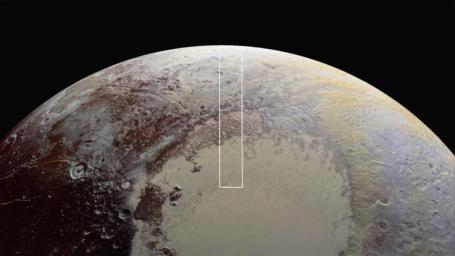New Horizons’ Very Best View of Pluto (movie)
Caption:
View the movie
This movie is composed of the sharpest views of Pluto that NASA's New Horizons spacecraft obtained during its flyby of the distant planet on July 14, 2015. The pictures are part of a sequence taken near New Horizons' closest approach to Pluto, with resolutions of about 250-280 feet (77-85 meters) per pixel -- revealing features smaller than half a city block on Pluto's diverse surface. The images include a wide variety of spectacular, cratered, mountainous and glacial terrains -- giving scientists and the public alike a breathtaking, super-high resolution window on Pluto's geology.
The images form a strip 50 miles (80 kilometers) wide trending from Pluto's jagged horizon about 500 miles (800 kilometers) northwest of the informally named Sputnik Planum, across the al-Idrisi mountains, onto the shoreline of Sputnik Planum and then across its icy plains. They were made with the telescopic Long Range Reconnaissance Imager (LORRI) aboard New Horizons, over a timespan of about a minute centered on 11:36 UT on July 14 -- just about 15 minutes before New Horizons' closest approach to Pluto -- from a range of just 10,000 miles (17,000 kilometers). They were obtained with an unusual observing mode; instead of working in the usual "point and shoot," LORRI snapped pictures every three seconds while the Ralph/Multispectral Visual Imaging Camera (MVIC) aboard New Horizons was scanning the surface. This mode requires unusually short exposures to avoid blurring the images.
All told, the images are six times better than the resolution of the global Pluto map New Horizons obtained, and five times better than the best images of Pluto's cousin Triton, Neptune's large moon, obtained by Voyager 2 in 1989.
Background Info:
The Johns Hopkins University Applied Physics Laboratory in Laurel, Maryland, designed, built, and operates the New Horizons spacecraft, and manages the mission for NASA's Science Mission Directorate. The Southwest Research Institute, based in San Antonio, leads the science team, payload operations and encounter science planning. New Horizons is part of the New Frontiers Program managed by NASA's Marshall Space Flight Center in Huntsville, Alabama.
Cataloging Keywords:
| Name |
Value |
Additional Values |
| Target |
Pluto |
Triton |
| System |
Pluto |
Kuiper Belt |
| Target Type |
Satellite |
Dwarf Planet, KBO |
| Mission |
New Horizons |
|
| Instrument Host |
New Horizons |
|
| Host Type |
Flyby Spacecraft |
|
| Instrument |
Long Range Reconnaissance Imager (LORRI) |
Multispectral Visible Imaging Camera (MVIC) |
| Detector |
|
|
| Extra Keywords |
Color, Crater, Map, Mountain, Visual |
| Acquisition Date |
|
| Release Date |
2015-12-05 |
| Date in Caption |
2015-07-14 |
|
| Image Credit |
NASA/Johns Hopkins University Applied Physics Laboratory/Southwest Research Institute |
| Source |
photojournal.jpl.nasa.gov/catalog/PIA20202 |
| Identifier |
PIA20202 |

 Planetary Data System
Planetary Data System
